Sustainable Competitive Advantage
VerifiedAdded on 2020/02/05
|14
|3952
|71
Essay
AI Summary
This assignment delves into the concept of sustainable competitive advantage. It examines various factors that contribute to a firm's ability to maintain a competitive edge over time, such as valuable resources, innovative capabilities, and effective knowledge management. The provided references offer insights into topics like resource-based theory, greening suppliers, dynamic capabilities, and stakeholder alliances. Students are expected to synthesize these ideas and demonstrate an understanding of how different elements contribute to long-term success in a competitive business environment.
Contribute Materials
Your contribution can guide someone’s learning journey. Share your
documents today.
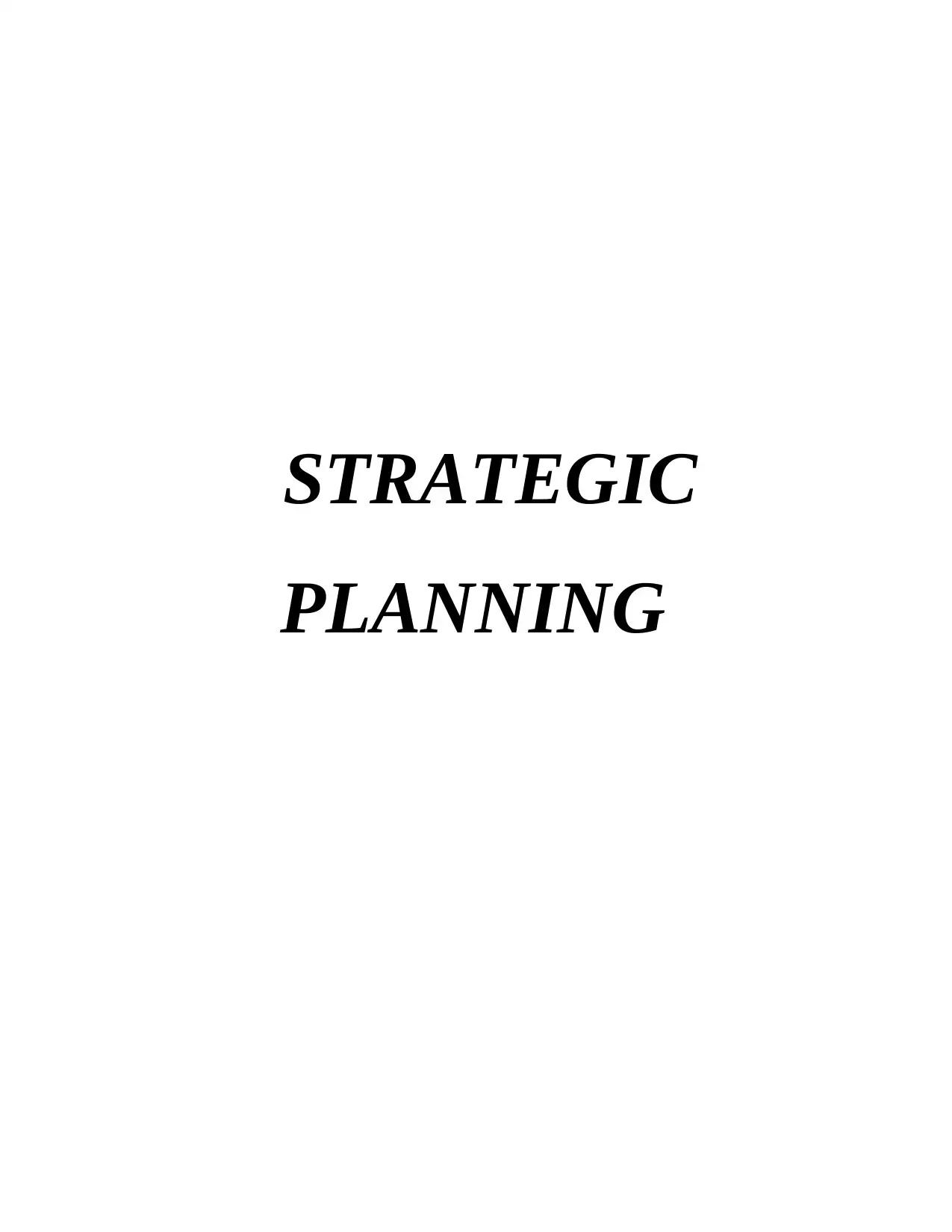
STRATEGIC
PLANNING
PLANNING
Secure Best Marks with AI Grader
Need help grading? Try our AI Grader for instant feedback on your assignments.
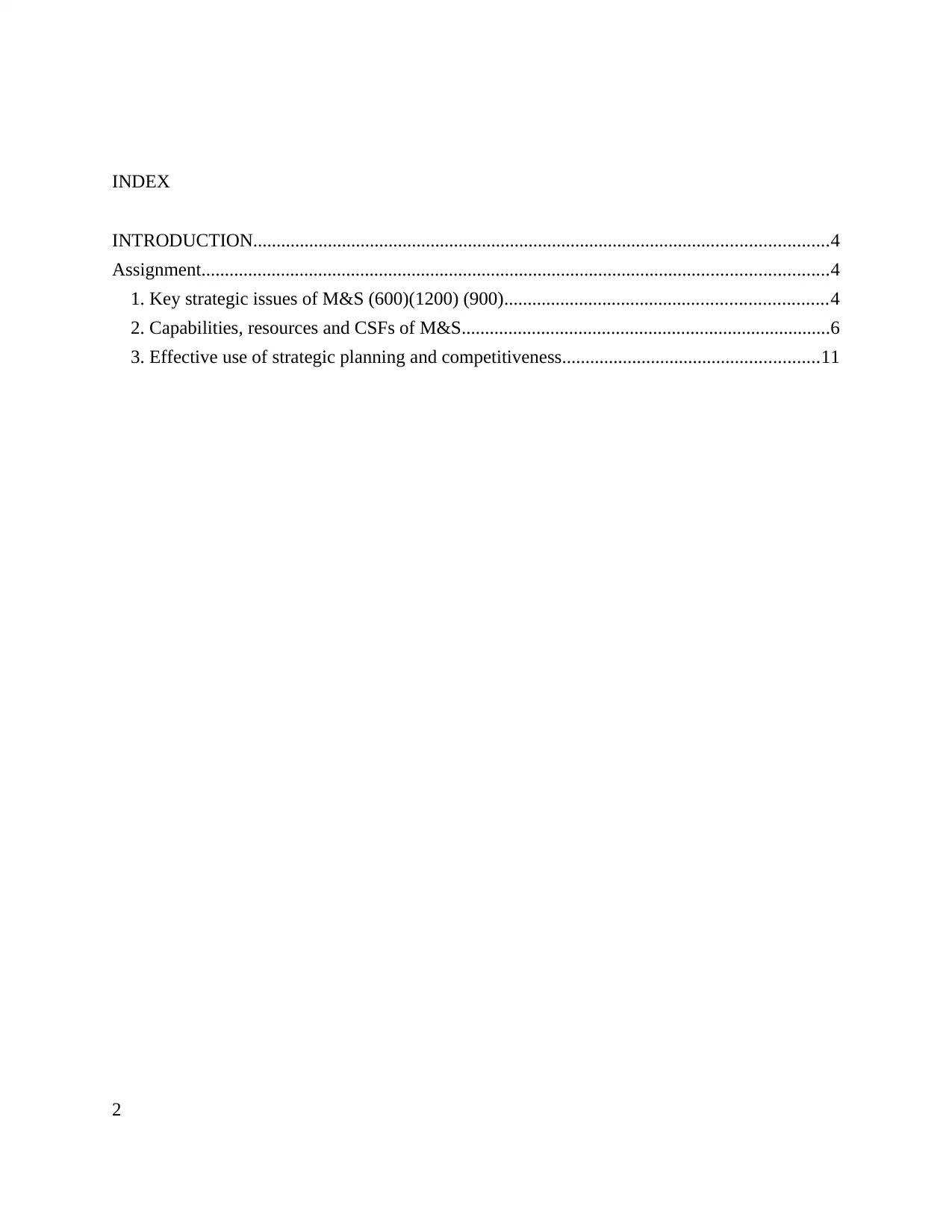
INDEX
INTRODUCTION...........................................................................................................................4
Assignment......................................................................................................................................4
1. Key strategic issues of M&S (600)(1200) (900).....................................................................4
2. Capabilities, resources and CSFs of M&S...............................................................................6
3. Effective use of strategic planning and competitiveness.......................................................11
2
INTRODUCTION...........................................................................................................................4
Assignment......................................................................................................................................4
1. Key strategic issues of M&S (600)(1200) (900).....................................................................4
2. Capabilities, resources and CSFs of M&S...............................................................................6
3. Effective use of strategic planning and competitiveness.......................................................11
2
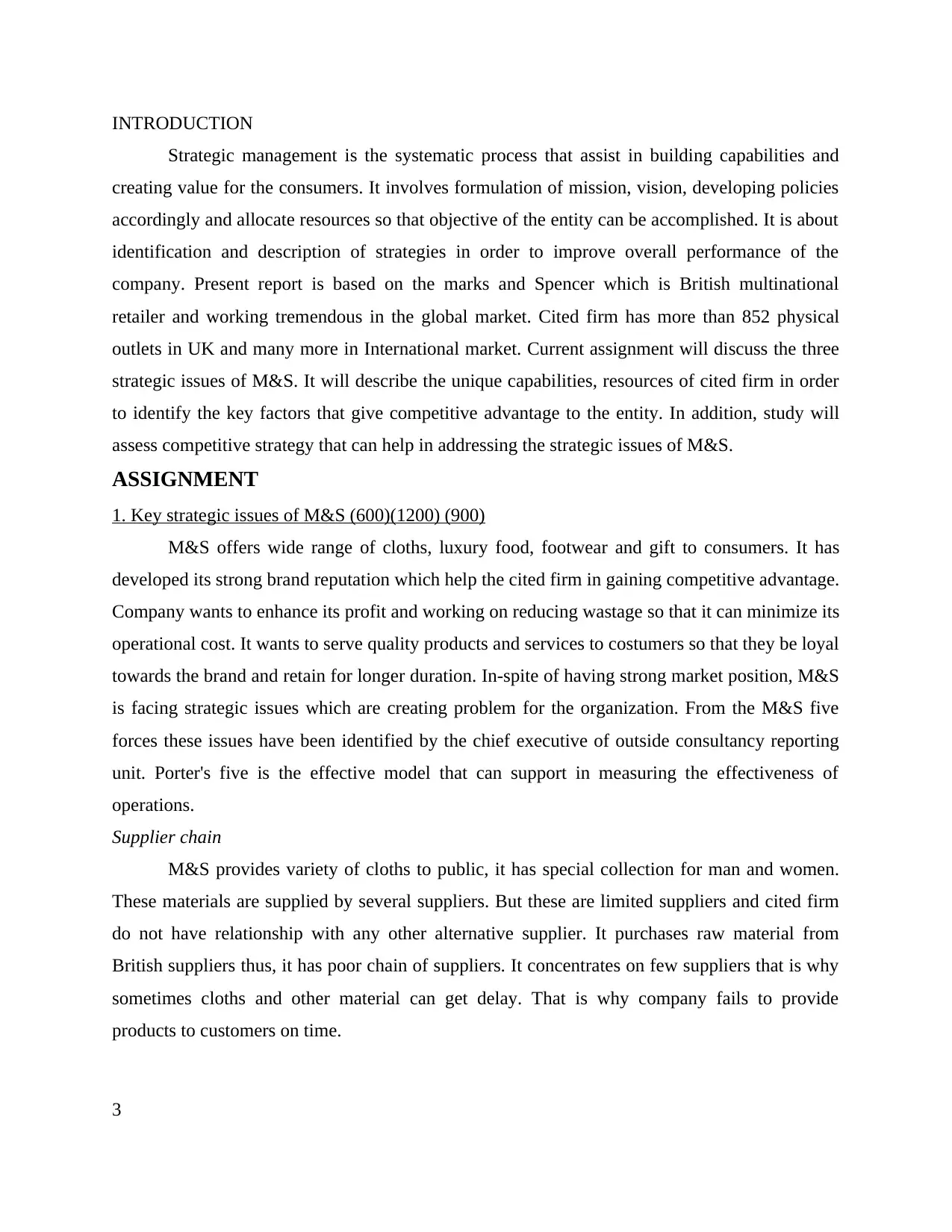
INTRODUCTION
Strategic management is the systematic process that assist in building capabilities and
creating value for the consumers. It involves formulation of mission, vision, developing policies
accordingly and allocate resources so that objective of the entity can be accomplished. It is about
identification and description of strategies in order to improve overall performance of the
company. Present report is based on the marks and Spencer which is British multinational
retailer and working tremendous in the global market. Cited firm has more than 852 physical
outlets in UK and many more in International market. Current assignment will discuss the three
strategic issues of M&S. It will describe the unique capabilities, resources of cited firm in order
to identify the key factors that give competitive advantage to the entity. In addition, study will
assess competitive strategy that can help in addressing the strategic issues of M&S.
ASSIGNMENT
1. Key strategic issues of M&S (600)(1200) (900)
M&S offers wide range of cloths, luxury food, footwear and gift to consumers. It has
developed its strong brand reputation which help the cited firm in gaining competitive advantage.
Company wants to enhance its profit and working on reducing wastage so that it can minimize its
operational cost. It wants to serve quality products and services to costumers so that they be loyal
towards the brand and retain for longer duration. In-spite of having strong market position, M&S
is facing strategic issues which are creating problem for the organization. From the M&S five
forces these issues have been identified by the chief executive of outside consultancy reporting
unit. Porter's five is the effective model that can support in measuring the effectiveness of
operations.
Supplier chain
M&S provides variety of cloths to public, it has special collection for man and women.
These materials are supplied by several suppliers. But these are limited suppliers and cited firm
do not have relationship with any other alternative supplier. It purchases raw material from
British suppliers thus, it has poor chain of suppliers. It concentrates on few suppliers that is why
sometimes cloths and other material can get delay. That is why company fails to provide
products to customers on time.
3
Strategic management is the systematic process that assist in building capabilities and
creating value for the consumers. It involves formulation of mission, vision, developing policies
accordingly and allocate resources so that objective of the entity can be accomplished. It is about
identification and description of strategies in order to improve overall performance of the
company. Present report is based on the marks and Spencer which is British multinational
retailer and working tremendous in the global market. Cited firm has more than 852 physical
outlets in UK and many more in International market. Current assignment will discuss the three
strategic issues of M&S. It will describe the unique capabilities, resources of cited firm in order
to identify the key factors that give competitive advantage to the entity. In addition, study will
assess competitive strategy that can help in addressing the strategic issues of M&S.
ASSIGNMENT
1. Key strategic issues of M&S (600)(1200) (900)
M&S offers wide range of cloths, luxury food, footwear and gift to consumers. It has
developed its strong brand reputation which help the cited firm in gaining competitive advantage.
Company wants to enhance its profit and working on reducing wastage so that it can minimize its
operational cost. It wants to serve quality products and services to costumers so that they be loyal
towards the brand and retain for longer duration. In-spite of having strong market position, M&S
is facing strategic issues which are creating problem for the organization. From the M&S five
forces these issues have been identified by the chief executive of outside consultancy reporting
unit. Porter's five is the effective model that can support in measuring the effectiveness of
operations.
Supplier chain
M&S provides variety of cloths to public, it has special collection for man and women.
These materials are supplied by several suppliers. But these are limited suppliers and cited firm
do not have relationship with any other alternative supplier. It purchases raw material from
British suppliers thus, it has poor chain of suppliers. It concentrates on few suppliers that is why
sometimes cloths and other material can get delay. That is why company fails to provide
products to customers on time.
3

Poor supplier chain is the main strategic issue for the M&S because due to this company
fails to provide products and services to end users on time. Sometimes due to this, problems
consumers buy from other brand. It turns their mind and they get negative towards the brand. For
making people loyal towards the organization it is essential that company offers them goods and
services as per their demand and if it fails then overall image of the organization get down.
Employees turn over
From the SWOT analyses of M&S it is found that marks and Spencer is facing the issue
of high employees turn over. It is another main problems in the organization which affects its
business performance badly. M&S follows tall organizational structure die to this, people can
not communicate directly with the higher authorities. The have to follow instruction of managers
strictly. Management of cited firm do not involve them in decision making process. Sometimes it
leads to negativity and that is why people feel unconformable in the workplace and they live the
job. Due to high employees turn over operational cost of the company is increasing day by day.
Though authorities provides them rewards and recognition to the best performer but it is done in
informal way. Managers give promotional opportunity to their favorite staff members that is why
other people feel dishearten and they find no career opportunities in the workplace. In addition,
no involvement of staff members in decision making process make them negative and they look
for new job. That is why company is facing the strategic issue of high retention rate of
employees turnover.
That is the strategic problems because due to this cited firm fails to accomplish its
objective significantly. When skilled people leave the job then M&S has to hire new candidate
and firm has to train them again. Apart from this efficiency level of new comers are lower than
experienced skill persons. Thus, they do not provide excellent services to consumers that
demotivate clients and turn their mind. This impact on the profitability of the company, sales
volume can get down due to poor service delivery.
Poor marketing strategy
From the PESTLE analyses it is found that Marks and Spencer is having poor marketing
strategies that is the strategic issues for the cited firm. M&S is advertising its products on TV and
using promotional camps to market its products. It is the modern era and there are advanced
technologies hat can support in marketing the product well. Internet is the biggest way that can
4
fails to provide products and services to end users on time. Sometimes due to this, problems
consumers buy from other brand. It turns their mind and they get negative towards the brand. For
making people loyal towards the organization it is essential that company offers them goods and
services as per their demand and if it fails then overall image of the organization get down.
Employees turn over
From the SWOT analyses of M&S it is found that marks and Spencer is facing the issue
of high employees turn over. It is another main problems in the organization which affects its
business performance badly. M&S follows tall organizational structure die to this, people can
not communicate directly with the higher authorities. The have to follow instruction of managers
strictly. Management of cited firm do not involve them in decision making process. Sometimes it
leads to negativity and that is why people feel unconformable in the workplace and they live the
job. Due to high employees turn over operational cost of the company is increasing day by day.
Though authorities provides them rewards and recognition to the best performer but it is done in
informal way. Managers give promotional opportunity to their favorite staff members that is why
other people feel dishearten and they find no career opportunities in the workplace. In addition,
no involvement of staff members in decision making process make them negative and they look
for new job. That is why company is facing the strategic issue of high retention rate of
employees turnover.
That is the strategic problems because due to this cited firm fails to accomplish its
objective significantly. When skilled people leave the job then M&S has to hire new candidate
and firm has to train them again. Apart from this efficiency level of new comers are lower than
experienced skill persons. Thus, they do not provide excellent services to consumers that
demotivate clients and turn their mind. This impact on the profitability of the company, sales
volume can get down due to poor service delivery.
Poor marketing strategy
From the PESTLE analyses it is found that Marks and Spencer is having poor marketing
strategies that is the strategic issues for the cited firm. M&S is advertising its products on TV and
using promotional camps to market its products. It is the modern era and there are advanced
technologies hat can support in marketing the product well. Internet is the biggest way that can
4
Secure Best Marks with AI Grader
Need help grading? Try our AI Grader for instant feedback on your assignments.
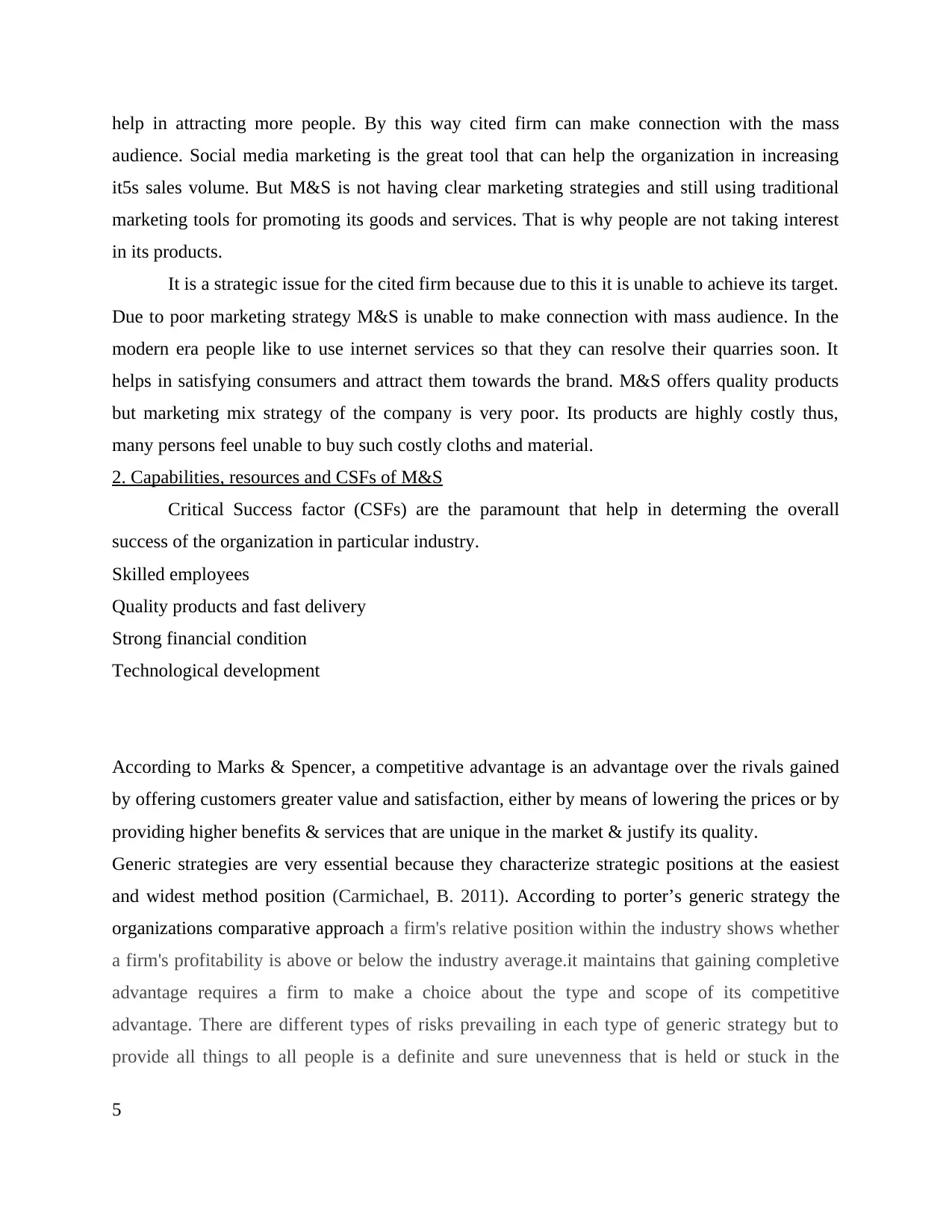
help in attracting more people. By this way cited firm can make connection with the mass
audience. Social media marketing is the great tool that can help the organization in increasing
it5s sales volume. But M&S is not having clear marketing strategies and still using traditional
marketing tools for promoting its goods and services. That is why people are not taking interest
in its products.
It is a strategic issue for the cited firm because due to this it is unable to achieve its target.
Due to poor marketing strategy M&S is unable to make connection with mass audience. In the
modern era people like to use internet services so that they can resolve their quarries soon. It
helps in satisfying consumers and attract them towards the brand. M&S offers quality products
but marketing mix strategy of the company is very poor. Its products are highly costly thus,
many persons feel unable to buy such costly cloths and material.
2. Capabilities, resources and CSFs of M&S
Critical Success factor (CSFs) are the paramount that help in determing the overall
success of the organization in particular industry.
Skilled employees
Quality products and fast delivery
Strong financial condition
Technological development
According to Marks & Spencer, a competitive advantage is an advantage over the rivals gained
by offering customers greater value and satisfaction, either by means of lowering the prices or by
providing higher benefits & services that are unique in the market & justify its quality.
Generic strategies are very essential because they characterize strategic positions at the easiest
and widest method position (Carmichael, B. 2011). According to porter’s generic strategy the
organizations comparative approach a firm's relative position within the industry shows whether
a firm's profitability is above or below the industry average.it maintains that gaining completive
advantage requires a firm to make a choice about the type and scope of its competitive
advantage. There are different types of risks prevailing in each type of generic strategy but to
provide all things to all people is a definite and sure unevenness that is held or stuck in the
5
audience. Social media marketing is the great tool that can help the organization in increasing
it5s sales volume. But M&S is not having clear marketing strategies and still using traditional
marketing tools for promoting its goods and services. That is why people are not taking interest
in its products.
It is a strategic issue for the cited firm because due to this it is unable to achieve its target.
Due to poor marketing strategy M&S is unable to make connection with mass audience. In the
modern era people like to use internet services so that they can resolve their quarries soon. It
helps in satisfying consumers and attract them towards the brand. M&S offers quality products
but marketing mix strategy of the company is very poor. Its products are highly costly thus,
many persons feel unable to buy such costly cloths and material.
2. Capabilities, resources and CSFs of M&S
Critical Success factor (CSFs) are the paramount that help in determing the overall
success of the organization in particular industry.
Skilled employees
Quality products and fast delivery
Strong financial condition
Technological development
According to Marks & Spencer, a competitive advantage is an advantage over the rivals gained
by offering customers greater value and satisfaction, either by means of lowering the prices or by
providing higher benefits & services that are unique in the market & justify its quality.
Generic strategies are very essential because they characterize strategic positions at the easiest
and widest method position (Carmichael, B. 2011). According to porter’s generic strategy the
organizations comparative approach a firm's relative position within the industry shows whether
a firm's profitability is above or below the industry average.it maintains that gaining completive
advantage requires a firm to make a choice about the type and scope of its competitive
advantage. There are different types of risks prevailing in each type of generic strategy but to
provide all things to all people is a definite and sure unevenness that is held or stuck in the
5
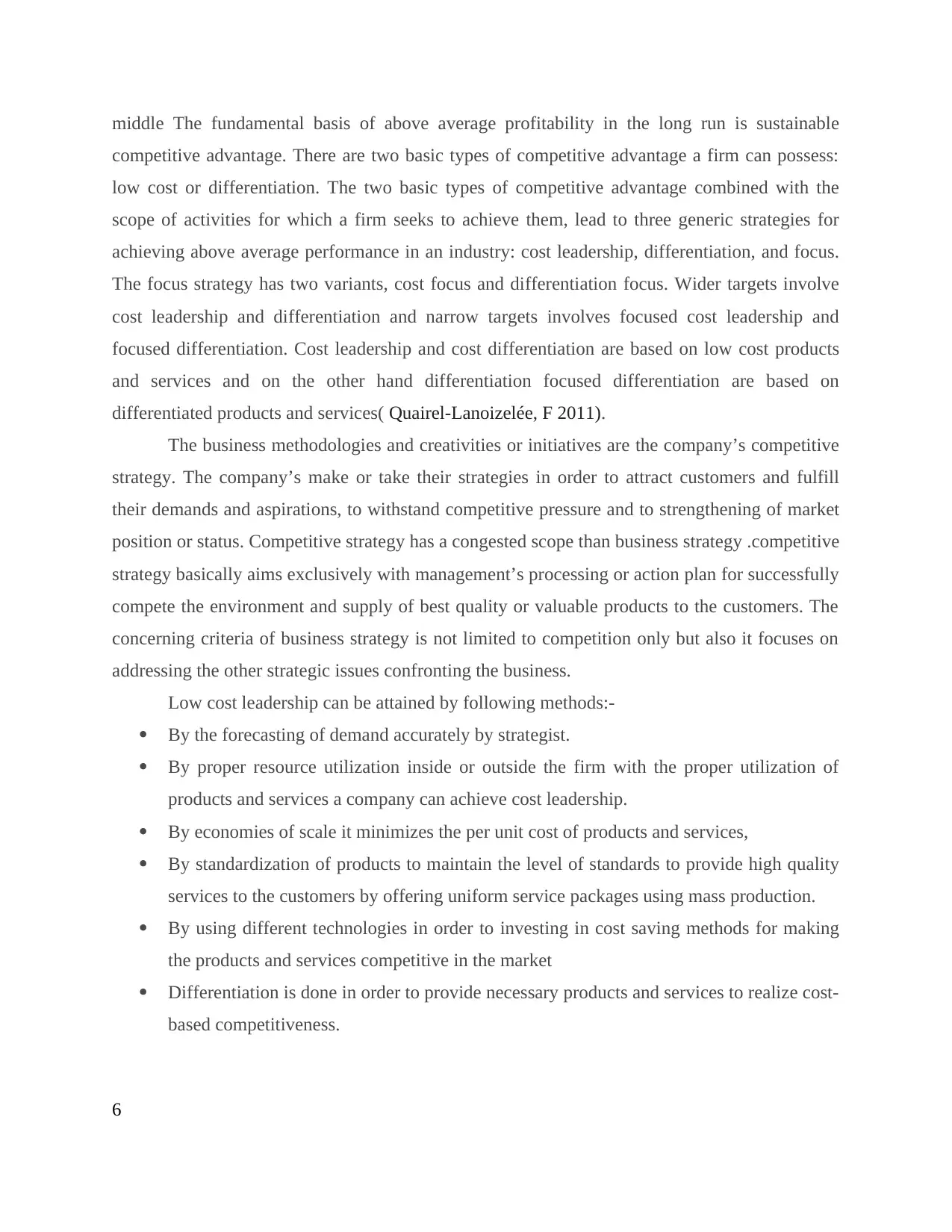
middle The fundamental basis of above average profitability in the long run is sustainable
competitive advantage. There are two basic types of competitive advantage a firm can possess:
low cost or differentiation. The two basic types of competitive advantage combined with the
scope of activities for which a firm seeks to achieve them, lead to three generic strategies for
achieving above average performance in an industry: cost leadership, differentiation, and focus.
The focus strategy has two variants, cost focus and differentiation focus. Wider targets involve
cost leadership and differentiation and narrow targets involves focused cost leadership and
focused differentiation. Cost leadership and cost differentiation are based on low cost products
and services and on the other hand differentiation focused differentiation are based on
differentiated products and services( Quairel-Lanoizelée, F 2011).
The business methodologies and creativities or initiatives are the company’s competitive
strategy. The company’s make or take their strategies in order to attract customers and fulfill
their demands and aspirations, to withstand competitive pressure and to strengthening of market
position or status. Competitive strategy has a congested scope than business strategy .competitive
strategy basically aims exclusively with management’s processing or action plan for successfully
compete the environment and supply of best quality or valuable products to the customers. The
concerning criteria of business strategy is not limited to competition only but also it focuses on
addressing the other strategic issues confronting the business.
Low cost leadership can be attained by following methods:-
By the forecasting of demand accurately by strategist.
By proper resource utilization inside or outside the firm with the proper utilization of
products and services a company can achieve cost leadership.
By economies of scale it minimizes the per unit cost of products and services,
By standardization of products to maintain the level of standards to provide high quality
services to the customers by offering uniform service packages using mass production.
By using different technologies in order to investing in cost saving methods for making
the products and services competitive in the market
Differentiation is done in order to provide necessary products and services to realize cost-
based competitiveness.
6
competitive advantage. There are two basic types of competitive advantage a firm can possess:
low cost or differentiation. The two basic types of competitive advantage combined with the
scope of activities for which a firm seeks to achieve them, lead to three generic strategies for
achieving above average performance in an industry: cost leadership, differentiation, and focus.
The focus strategy has two variants, cost focus and differentiation focus. Wider targets involve
cost leadership and differentiation and narrow targets involves focused cost leadership and
focused differentiation. Cost leadership and cost differentiation are based on low cost products
and services and on the other hand differentiation focused differentiation are based on
differentiated products and services( Quairel-Lanoizelée, F 2011).
The business methodologies and creativities or initiatives are the company’s competitive
strategy. The company’s make or take their strategies in order to attract customers and fulfill
their demands and aspirations, to withstand competitive pressure and to strengthening of market
position or status. Competitive strategy has a congested scope than business strategy .competitive
strategy basically aims exclusively with management’s processing or action plan for successfully
compete the environment and supply of best quality or valuable products to the customers. The
concerning criteria of business strategy is not limited to competition only but also it focuses on
addressing the other strategic issues confronting the business.
Low cost leadership can be attained by following methods:-
By the forecasting of demand accurately by strategist.
By proper resource utilization inside or outside the firm with the proper utilization of
products and services a company can achieve cost leadership.
By economies of scale it minimizes the per unit cost of products and services,
By standardization of products to maintain the level of standards to provide high quality
services to the customers by offering uniform service packages using mass production.
By using different technologies in order to investing in cost saving methods for making
the products and services competitive in the market
Differentiation is done in order to provide necessary products and services to realize cost-
based competitiveness.
6
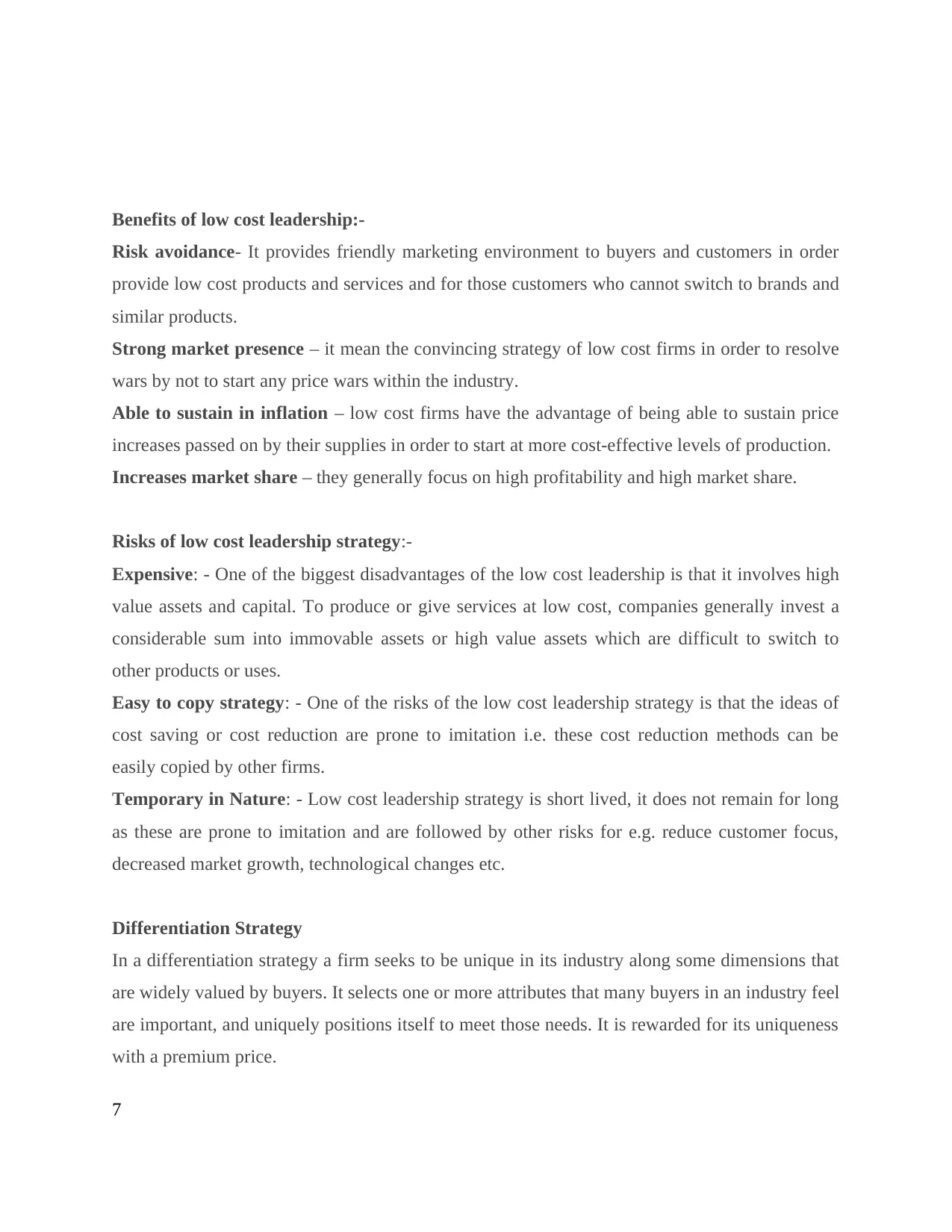
Benefits of low cost leadership:-
Risk avoidance- It provides friendly marketing environment to buyers and customers in order
provide low cost products and services and for those customers who cannot switch to brands and
similar products.
Strong market presence – it mean the convincing strategy of low cost firms in order to resolve
wars by not to start any price wars within the industry.
Able to sustain in inflation – low cost firms have the advantage of being able to sustain price
increases passed on by their supplies in order to start at more cost-effective levels of production.
Increases market share – they generally focus on high profitability and high market share.
Risks of low cost leadership strategy:-
Expensive: - One of the biggest disadvantages of the low cost leadership is that it involves high
value assets and capital. To produce or give services at low cost, companies generally invest a
considerable sum into immovable assets or high value assets which are difficult to switch to
other products or uses.
Easy to copy strategy: - One of the risks of the low cost leadership strategy is that the ideas of
cost saving or cost reduction are prone to imitation i.e. these cost reduction methods can be
easily copied by other firms.
Temporary in Nature: - Low cost leadership strategy is short lived, it does not remain for long
as these are prone to imitation and are followed by other risks for e.g. reduce customer focus,
decreased market growth, technological changes etc.
Differentiation Strategy
In a differentiation strategy a firm seeks to be unique in its industry along some dimensions that
are widely valued by buyers. It selects one or more attributes that many buyers in an industry feel
are important, and uniquely positions itself to meet those needs. It is rewarded for its uniqueness
with a premium price.
7
Risk avoidance- It provides friendly marketing environment to buyers and customers in order
provide low cost products and services and for those customers who cannot switch to brands and
similar products.
Strong market presence – it mean the convincing strategy of low cost firms in order to resolve
wars by not to start any price wars within the industry.
Able to sustain in inflation – low cost firms have the advantage of being able to sustain price
increases passed on by their supplies in order to start at more cost-effective levels of production.
Increases market share – they generally focus on high profitability and high market share.
Risks of low cost leadership strategy:-
Expensive: - One of the biggest disadvantages of the low cost leadership is that it involves high
value assets and capital. To produce or give services at low cost, companies generally invest a
considerable sum into immovable assets or high value assets which are difficult to switch to
other products or uses.
Easy to copy strategy: - One of the risks of the low cost leadership strategy is that the ideas of
cost saving or cost reduction are prone to imitation i.e. these cost reduction methods can be
easily copied by other firms.
Temporary in Nature: - Low cost leadership strategy is short lived, it does not remain for long
as these are prone to imitation and are followed by other risks for e.g. reduce customer focus,
decreased market growth, technological changes etc.
Differentiation Strategy
In a differentiation strategy a firm seeks to be unique in its industry along some dimensions that
are widely valued by buyers. It selects one or more attributes that many buyers in an industry feel
are important, and uniquely positions itself to meet those needs. It is rewarded for its uniqueness
with a premium price.
7
Paraphrase This Document
Need a fresh take? Get an instant paraphrase of this document with our AI Paraphraser
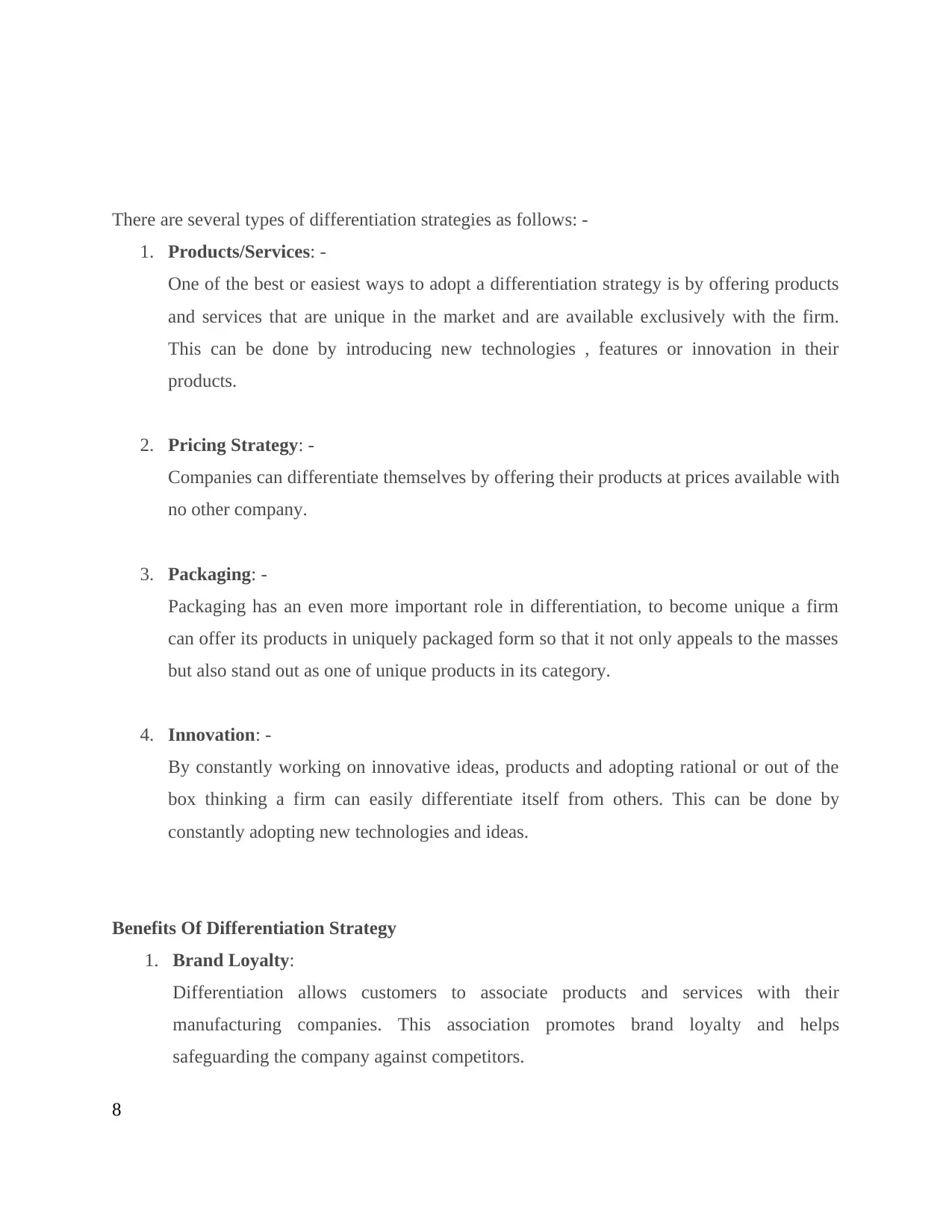
There are several types of differentiation strategies as follows: -
1. Products/Services: -
One of the best or easiest ways to adopt a differentiation strategy is by offering products
and services that are unique in the market and are available exclusively with the firm.
This can be done by introducing new technologies , features or innovation in their
products.
2. Pricing Strategy: -
Companies can differentiate themselves by offering their products at prices available with
no other company.
3. Packaging: -
Packaging has an even more important role in differentiation, to become unique a firm
can offer its products in uniquely packaged form so that it not only appeals to the masses
but also stand out as one of unique products in its category.
4. Innovation: -
By constantly working on innovative ideas, products and adopting rational or out of the
box thinking a firm can easily differentiate itself from others. This can be done by
constantly adopting new technologies and ideas.
Benefits Of Differentiation Strategy
1. Brand Loyalty:
Differentiation allows customers to associate products and services with their
manufacturing companies. This association promotes brand loyalty and helps
safeguarding the company against competitors.
8
1. Products/Services: -
One of the best or easiest ways to adopt a differentiation strategy is by offering products
and services that are unique in the market and are available exclusively with the firm.
This can be done by introducing new technologies , features or innovation in their
products.
2. Pricing Strategy: -
Companies can differentiate themselves by offering their products at prices available with
no other company.
3. Packaging: -
Packaging has an even more important role in differentiation, to become unique a firm
can offer its products in uniquely packaged form so that it not only appeals to the masses
but also stand out as one of unique products in its category.
4. Innovation: -
By constantly working on innovative ideas, products and adopting rational or out of the
box thinking a firm can easily differentiate itself from others. This can be done by
constantly adopting new technologies and ideas.
Benefits Of Differentiation Strategy
1. Brand Loyalty:
Differentiation allows customers to associate products and services with their
manufacturing companies. This association promotes brand loyalty and helps
safeguarding the company against competitors.
8
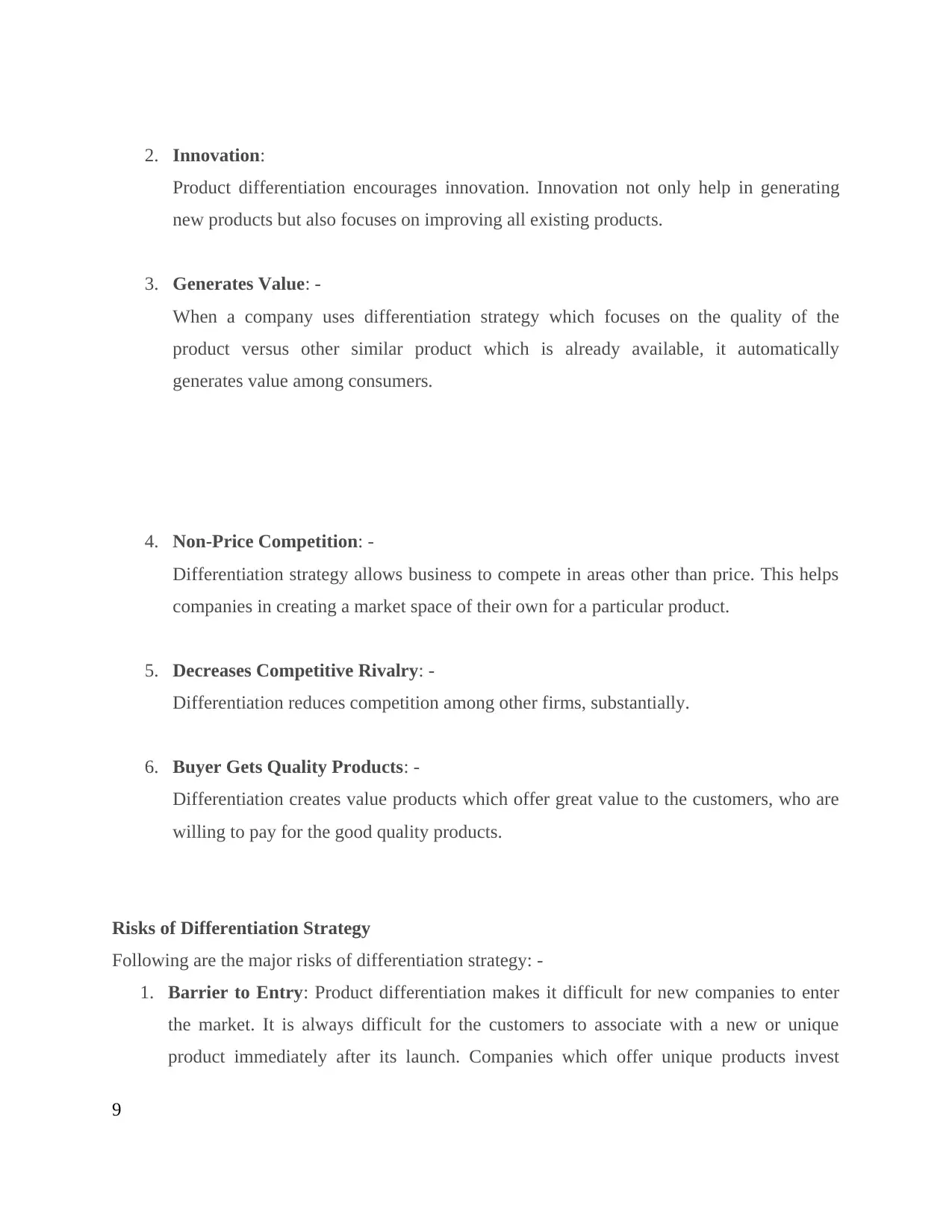
2. Innovation:
Product differentiation encourages innovation. Innovation not only help in generating
new products but also focuses on improving all existing products.
3. Generates Value: -
When a company uses differentiation strategy which focuses on the quality of the
product versus other similar product which is already available, it automatically
generates value among consumers.
4. Non-Price Competition: -
Differentiation strategy allows business to compete in areas other than price. This helps
companies in creating a market space of their own for a particular product.
5. Decreases Competitive Rivalry: -
Differentiation reduces competition among other firms, substantially.
6. Buyer Gets Quality Products: -
Differentiation creates value products which offer great value to the customers, who are
willing to pay for the good quality products.
Risks of Differentiation Strategy
Following are the major risks of differentiation strategy: -
1. Barrier to Entry: Product differentiation makes it difficult for new companies to enter
the market. It is always difficult for the customers to associate with a new or unique
product immediately after its launch. Companies which offer unique products invest
9
Product differentiation encourages innovation. Innovation not only help in generating
new products but also focuses on improving all existing products.
3. Generates Value: -
When a company uses differentiation strategy which focuses on the quality of the
product versus other similar product which is already available, it automatically
generates value among consumers.
4. Non-Price Competition: -
Differentiation strategy allows business to compete in areas other than price. This helps
companies in creating a market space of their own for a particular product.
5. Decreases Competitive Rivalry: -
Differentiation reduces competition among other firms, substantially.
6. Buyer Gets Quality Products: -
Differentiation creates value products which offer great value to the customers, who are
willing to pay for the good quality products.
Risks of Differentiation Strategy
Following are the major risks of differentiation strategy: -
1. Barrier to Entry: Product differentiation makes it difficult for new companies to enter
the market. It is always difficult for the customers to associate with a new or unique
product immediately after its launch. Companies which offer unique products invest
9
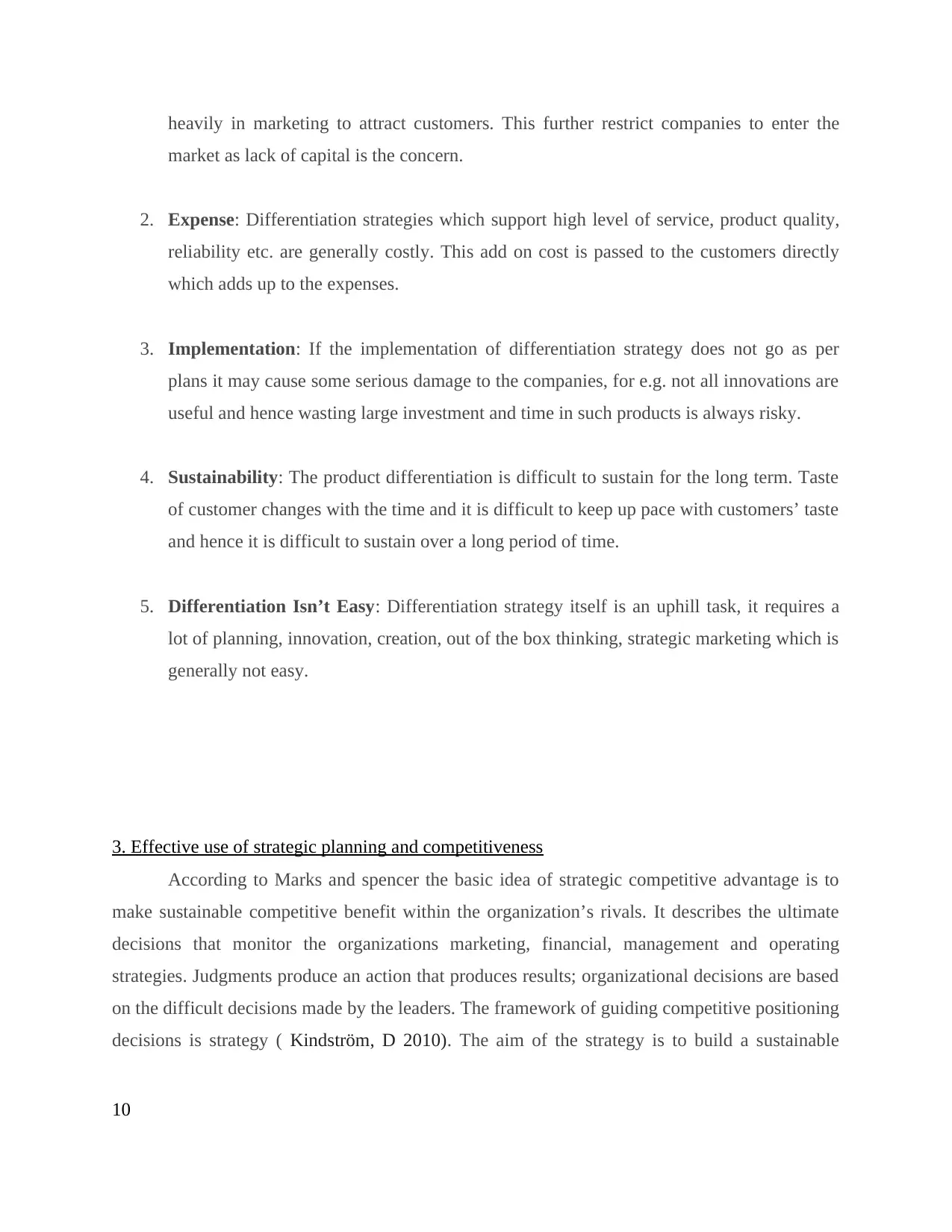
heavily in marketing to attract customers. This further restrict companies to enter the
market as lack of capital is the concern.
2. Expense: Differentiation strategies which support high level of service, product quality,
reliability etc. are generally costly. This add on cost is passed to the customers directly
which adds up to the expenses.
3. Implementation: If the implementation of differentiation strategy does not go as per
plans it may cause some serious damage to the companies, for e.g. not all innovations are
useful and hence wasting large investment and time in such products is always risky.
4. Sustainability: The product differentiation is difficult to sustain for the long term. Taste
of customer changes with the time and it is difficult to keep up pace with customers’ taste
and hence it is difficult to sustain over a long period of time.
5. Differentiation Isn’t Easy: Differentiation strategy itself is an uphill task, it requires a
lot of planning, innovation, creation, out of the box thinking, strategic marketing which is
generally not easy.
3. Effective use of strategic planning and competitiveness
According to Marks and spencer the basic idea of strategic competitive advantage is to
make sustainable competitive benefit within the organization’s rivals. It describes the ultimate
decisions that monitor the organizations marketing, financial, management and operating
strategies. Judgments produce an action that produces results; organizational decisions are based
on the difficult decisions made by the leaders. The framework of guiding competitive positioning
decisions is strategy ( Kindström, D 2010). The aim of the strategy is to build a sustainable
10
market as lack of capital is the concern.
2. Expense: Differentiation strategies which support high level of service, product quality,
reliability etc. are generally costly. This add on cost is passed to the customers directly
which adds up to the expenses.
3. Implementation: If the implementation of differentiation strategy does not go as per
plans it may cause some serious damage to the companies, for e.g. not all innovations are
useful and hence wasting large investment and time in such products is always risky.
4. Sustainability: The product differentiation is difficult to sustain for the long term. Taste
of customer changes with the time and it is difficult to keep up pace with customers’ taste
and hence it is difficult to sustain over a long period of time.
5. Differentiation Isn’t Easy: Differentiation strategy itself is an uphill task, it requires a
lot of planning, innovation, creation, out of the box thinking, strategic marketing which is
generally not easy.
3. Effective use of strategic planning and competitiveness
According to Marks and spencer the basic idea of strategic competitive advantage is to
make sustainable competitive benefit within the organization’s rivals. It describes the ultimate
decisions that monitor the organizations marketing, financial, management and operating
strategies. Judgments produce an action that produces results; organizational decisions are based
on the difficult decisions made by the leaders. The framework of guiding competitive positioning
decisions is strategy ( Kindström, D 2010). The aim of the strategy is to build a sustainable
10
Secure Best Marks with AI Grader
Need help grading? Try our AI Grader for instant feedback on your assignments.

competitive advantage over the organizations rivals. The competitive strategy is all about how to
define the business for today and tomorrow. The competition between industries and rivals.
Addressing the competitive forces of industries or markets (suppliers, new entry’s, customers
and product substitute). Fundamental aim of strategy is to attain competitive advantage in low
price and differentiation, Size of market plan for the achievement and Visualization on growth
by acquisition or profit margins.
The sole aim to formulate a strategy lays in accepting and overwhelming the system boundary
that hinder the achievement of organizational goals. A valuable strategy mesmerizes the barriers
and develops decisions and choices that confront them.
Different strategic approaches-
Offensive strategy – it overcome the barrier for the achievement of targets by changing the
systematic relational development strategy. This requires important capital investment and
comprises the changing or varying the competitive structure or fluctuations in the competitive
structure of the organization or most importantly organizational environment by onward or
recessive addition and obtaining competitors as. well.
Anticipating industry helps in product positioning, differentiation and substitutes for the
development process in the organization in order to remain competitive.
Defensive strategy – in order to maintain the positioning process, defending strategy is used by
accepting the industry’s competitive forces( Witell L, 2011).
Core competencies are basically organizational competencies in order to achieve competitive
advantage. They are unique in nature and practical capabilities to the concept of integration and
mix up the skills, knowledge and competencies of an employee to a wider spectrum. Experience
are taken by design, fabrication, testing, programming, computer controller, planning, budgeting
and cost reduction as well. There are some other experience like attracting and retaining talent,
developing and interaction with customers with respect to delivery schedules.
Organizational competencies provide product characteristics, service attributes and
intangible feature which will help convince the customers to purchase the products and services.
11
define the business for today and tomorrow. The competition between industries and rivals.
Addressing the competitive forces of industries or markets (suppliers, new entry’s, customers
and product substitute). Fundamental aim of strategy is to attain competitive advantage in low
price and differentiation, Size of market plan for the achievement and Visualization on growth
by acquisition or profit margins.
The sole aim to formulate a strategy lays in accepting and overwhelming the system boundary
that hinder the achievement of organizational goals. A valuable strategy mesmerizes the barriers
and develops decisions and choices that confront them.
Different strategic approaches-
Offensive strategy – it overcome the barrier for the achievement of targets by changing the
systematic relational development strategy. This requires important capital investment and
comprises the changing or varying the competitive structure or fluctuations in the competitive
structure of the organization or most importantly organizational environment by onward or
recessive addition and obtaining competitors as. well.
Anticipating industry helps in product positioning, differentiation and substitutes for the
development process in the organization in order to remain competitive.
Defensive strategy – in order to maintain the positioning process, defending strategy is used by
accepting the industry’s competitive forces( Witell L, 2011).
Core competencies are basically organizational competencies in order to achieve competitive
advantage. They are unique in nature and practical capabilities to the concept of integration and
mix up the skills, knowledge and competencies of an employee to a wider spectrum. Experience
are taken by design, fabrication, testing, programming, computer controller, planning, budgeting
and cost reduction as well. There are some other experience like attracting and retaining talent,
developing and interaction with customers with respect to delivery schedules.
Organizational competencies provide product characteristics, service attributes and
intangible feature which will help convince the customers to purchase the products and services.
11
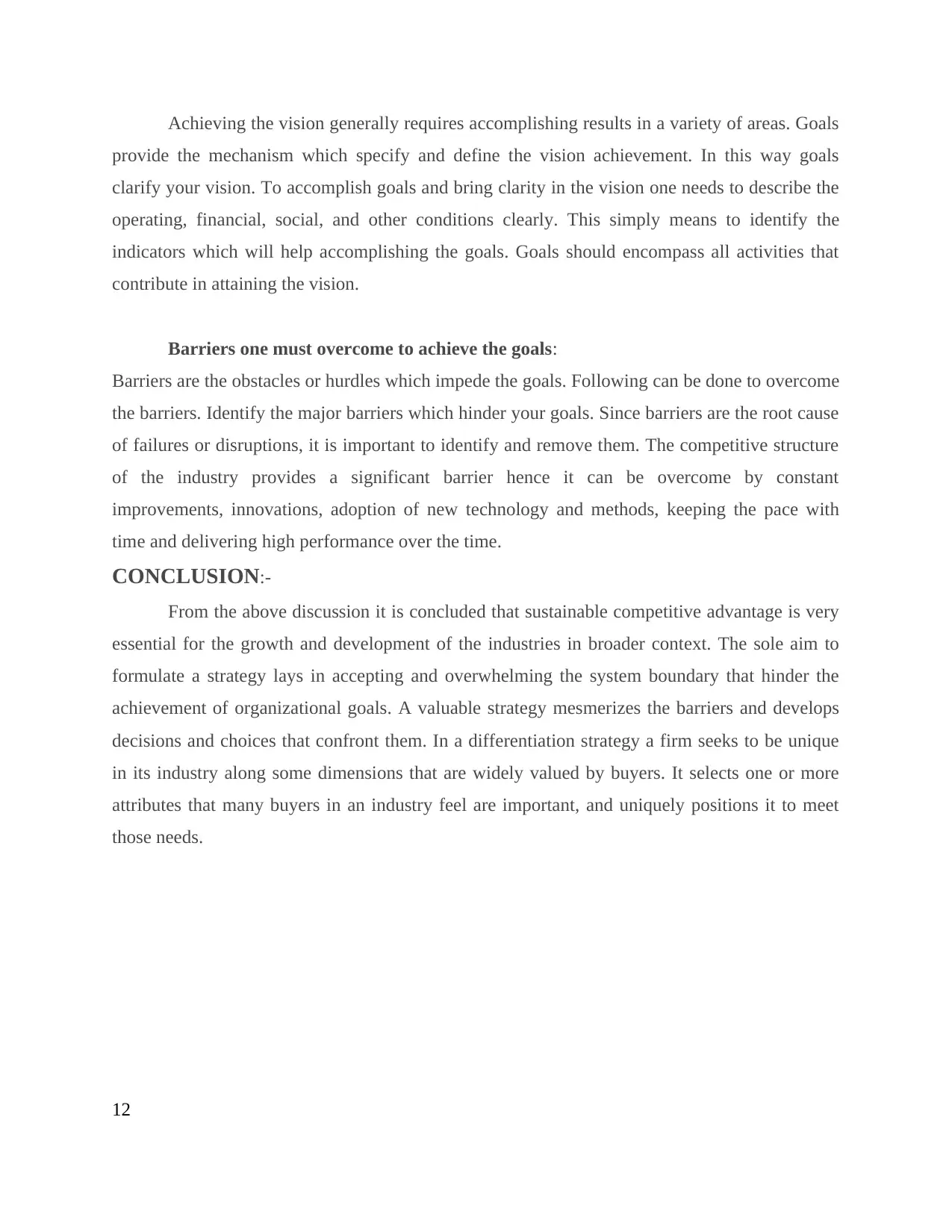
Achieving the vision generally requires accomplishing results in a variety of areas. Goals
provide the mechanism which specify and define the vision achievement. In this way goals
clarify your vision. To accomplish goals and bring clarity in the vision one needs to describe the
operating, financial, social, and other conditions clearly. This simply means to identify the
indicators which will help accomplishing the goals. Goals should encompass all activities that
contribute in attaining the vision.
Barriers one must overcome to achieve the goals:
Barriers are the obstacles or hurdles which impede the goals. Following can be done to overcome
the barriers. Identify the major barriers which hinder your goals. Since barriers are the root cause
of failures or disruptions, it is important to identify and remove them. The competitive structure
of the industry provides a significant barrier hence it can be overcome by constant
improvements, innovations, adoption of new technology and methods, keeping the pace with
time and delivering high performance over the time.
CONCLUSION:-
From the above discussion it is concluded that sustainable competitive advantage is very
essential for the growth and development of the industries in broader context. The sole aim to
formulate a strategy lays in accepting and overwhelming the system boundary that hinder the
achievement of organizational goals. A valuable strategy mesmerizes the barriers and develops
decisions and choices that confront them. In a differentiation strategy a firm seeks to be unique
in its industry along some dimensions that are widely valued by buyers. It selects one or more
attributes that many buyers in an industry feel are important, and uniquely positions it to meet
those needs.
12
provide the mechanism which specify and define the vision achievement. In this way goals
clarify your vision. To accomplish goals and bring clarity in the vision one needs to describe the
operating, financial, social, and other conditions clearly. This simply means to identify the
indicators which will help accomplishing the goals. Goals should encompass all activities that
contribute in attaining the vision.
Barriers one must overcome to achieve the goals:
Barriers are the obstacles or hurdles which impede the goals. Following can be done to overcome
the barriers. Identify the major barriers which hinder your goals. Since barriers are the root cause
of failures or disruptions, it is important to identify and remove them. The competitive structure
of the industry provides a significant barrier hence it can be overcome by constant
improvements, innovations, adoption of new technology and methods, keeping the pace with
time and delivering high performance over the time.
CONCLUSION:-
From the above discussion it is concluded that sustainable competitive advantage is very
essential for the growth and development of the industries in broader context. The sole aim to
formulate a strategy lays in accepting and overwhelming the system boundary that hinder the
achievement of organizational goals. A valuable strategy mesmerizes the barriers and develops
decisions and choices that confront them. In a differentiation strategy a firm seeks to be unique
in its industry along some dimensions that are widely valued by buyers. It selects one or more
attributes that many buyers in an industry feel are important, and uniquely positions it to meet
those needs.
12
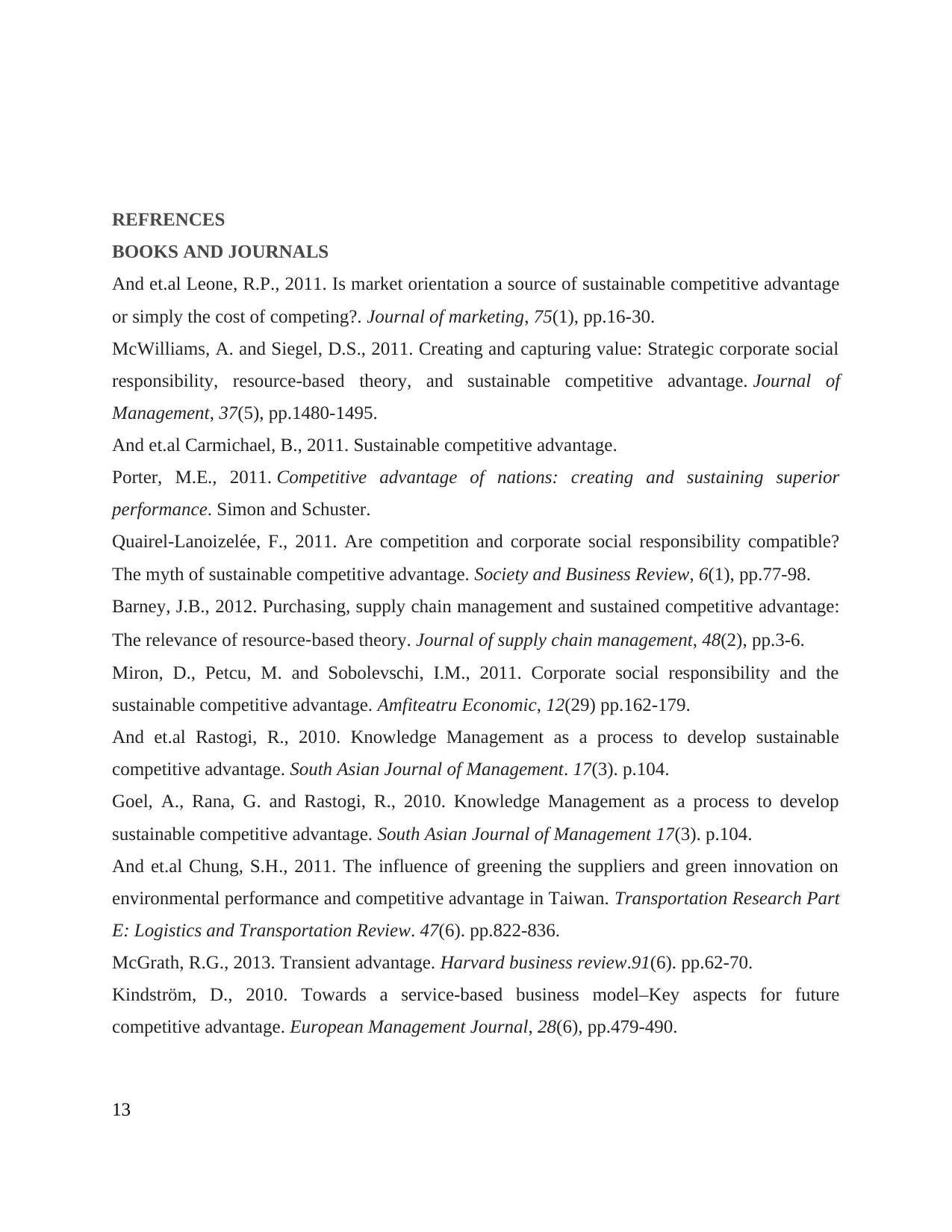
REFRENCES
BOOKS AND JOURNALS
And et.al Leone, R.P., 2011. Is market orientation a source of sustainable competitive advantage
or simply the cost of competing?. Journal of marketing, 75(1), pp.16-30.
McWilliams, A. and Siegel, D.S., 2011. Creating and capturing value: Strategic corporate social
responsibility, resource-based theory, and sustainable competitive advantage. Journal of
Management, 37(5), pp.1480-1495.
And et.al Carmichael, B., 2011. Sustainable competitive advantage.
Porter, M.E., 2011. Competitive advantage of nations: creating and sustaining superior
performance. Simon and Schuster.
Quairel-Lanoizelée, F., 2011. Are competition and corporate social responsibility compatible?
The myth of sustainable competitive advantage. Society and Business Review, 6(1), pp.77-98.
Barney, J.B., 2012. Purchasing, supply chain management and sustained competitive advantage:
The relevance of resource‐based theory. Journal of supply chain management, 48(2), pp.3-6.
Miron, D., Petcu, M. and Sobolevschi, I.M., 2011. Corporate social responsibility and the
sustainable competitive advantage. Amfiteatru Economic, 12(29) pp.162-179.
And et.al Rastogi, R., 2010. Knowledge Management as a process to develop sustainable
competitive advantage. South Asian Journal of Management. 17(3). p.104.
Goel, A., Rana, G. and Rastogi, R., 2010. Knowledge Management as a process to develop
sustainable competitive advantage. South Asian Journal of Management 17(3). p.104.
And et.al Chung, S.H., 2011. The influence of greening the suppliers and green innovation on
environmental performance and competitive advantage in Taiwan. Transportation Research Part
E: Logistics and Transportation Review. 47(6). pp.822-836.
McGrath, R.G., 2013. Transient advantage. Harvard business review.91(6). pp.62-70.
Kindström, D., 2010. Towards a service-based business model–Key aspects for future
competitive advantage. European Management Journal, 28(6), pp.479-490.
13
BOOKS AND JOURNALS
And et.al Leone, R.P., 2011. Is market orientation a source of sustainable competitive advantage
or simply the cost of competing?. Journal of marketing, 75(1), pp.16-30.
McWilliams, A. and Siegel, D.S., 2011. Creating and capturing value: Strategic corporate social
responsibility, resource-based theory, and sustainable competitive advantage. Journal of
Management, 37(5), pp.1480-1495.
And et.al Carmichael, B., 2011. Sustainable competitive advantage.
Porter, M.E., 2011. Competitive advantage of nations: creating and sustaining superior
performance. Simon and Schuster.
Quairel-Lanoizelée, F., 2011. Are competition and corporate social responsibility compatible?
The myth of sustainable competitive advantage. Society and Business Review, 6(1), pp.77-98.
Barney, J.B., 2012. Purchasing, supply chain management and sustained competitive advantage:
The relevance of resource‐based theory. Journal of supply chain management, 48(2), pp.3-6.
Miron, D., Petcu, M. and Sobolevschi, I.M., 2011. Corporate social responsibility and the
sustainable competitive advantage. Amfiteatru Economic, 12(29) pp.162-179.
And et.al Rastogi, R., 2010. Knowledge Management as a process to develop sustainable
competitive advantage. South Asian Journal of Management. 17(3). p.104.
Goel, A., Rana, G. and Rastogi, R., 2010. Knowledge Management as a process to develop
sustainable competitive advantage. South Asian Journal of Management 17(3). p.104.
And et.al Chung, S.H., 2011. The influence of greening the suppliers and green innovation on
environmental performance and competitive advantage in Taiwan. Transportation Research Part
E: Logistics and Transportation Review. 47(6). pp.822-836.
McGrath, R.G., 2013. Transient advantage. Harvard business review.91(6). pp.62-70.
Kindström, D., 2010. Towards a service-based business model–Key aspects for future
competitive advantage. European Management Journal, 28(6), pp.479-490.
13
Paraphrase This Document
Need a fresh take? Get an instant paraphrase of this document with our AI Paraphraser

And et.al Wu, Y., 2011. Green strategy for gaining competitive advantage in housing
development: a China study. Journal of Cleaner Production, 19(2), pp.157-167.
Marjanovic, O. and Freeze, R., 2012. Knowledge‐Intensive Business Process: Deriving a
Sustainable Competitive Advantage through Business Process Management and Knowledge
Management Integration. Knowledge and Process Management, 19(4), pp.180-188.
Cui, Y. and Jiao, H., 2011. Dynamic capabilities, strategic stakeholder alliances and sustainable
competitive advantage: evidence from China. Corporate Governance: The international journal
of business in society. 11(4). pp.386-398.
Agus, A., 2011. Enhancing production performance and customer performance through total
quality management (TQM): strategies for competitive advantage. Procedia-Social and
Behavioral Sciences. 24, pp.1650-1662.
And et.al Witell, L., 2011. Competitive advantage through service differentiation by
manufacturing companies. Journal of Business Research. 64(12). pp.1270-1280.
14
development: a China study. Journal of Cleaner Production, 19(2), pp.157-167.
Marjanovic, O. and Freeze, R., 2012. Knowledge‐Intensive Business Process: Deriving a
Sustainable Competitive Advantage through Business Process Management and Knowledge
Management Integration. Knowledge and Process Management, 19(4), pp.180-188.
Cui, Y. and Jiao, H., 2011. Dynamic capabilities, strategic stakeholder alliances and sustainable
competitive advantage: evidence from China. Corporate Governance: The international journal
of business in society. 11(4). pp.386-398.
Agus, A., 2011. Enhancing production performance and customer performance through total
quality management (TQM): strategies for competitive advantage. Procedia-Social and
Behavioral Sciences. 24, pp.1650-1662.
And et.al Witell, L., 2011. Competitive advantage through service differentiation by
manufacturing companies. Journal of Business Research. 64(12). pp.1270-1280.
14
1 out of 14
Related Documents
Your All-in-One AI-Powered Toolkit for Academic Success.
+13062052269
info@desklib.com
Available 24*7 on WhatsApp / Email
![[object Object]](/_next/static/media/star-bottom.7253800d.svg)
Unlock your academic potential
© 2024 | Zucol Services PVT LTD | All rights reserved.




